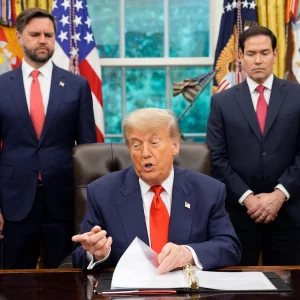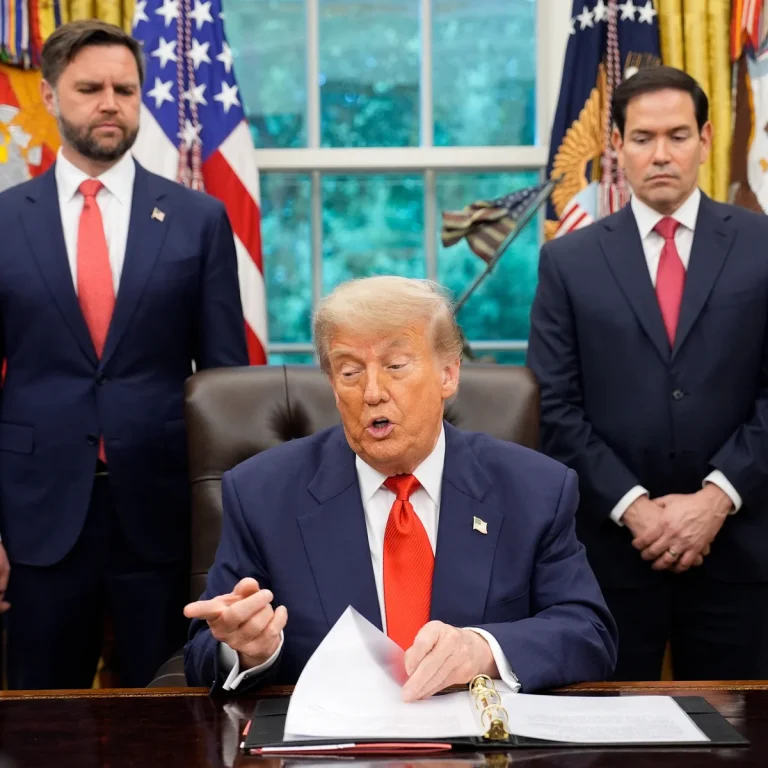Trump Halts Biden-Era East Coast Offshore Wind Project, Citing ‘Energy Dominance’ Agenda
The Trump administration is taking aggressive steps to roll back Biden-era green energy initiatives, announcing Friday that it has halted a massive offshore wind project off the coasts of Rhode Island and Connecticut.
The Department of the Interior (DOI) confirmed that the Bureau of Ocean Energy Management (BOEM) has stopped work on the Revolution Wind project, which was previously approved under President Joe Biden in 2023. The move marks a significant pivot in U.S. energy policy, as the Trump team doubles down on what it calls “reliable, affordable, America-first energy.”
“Americans deserve energy that is affordable, reliable, and built to last — not experimental and expensive wind projects that are proven failures,” said DOI deputy press secretary Aubrie Spady. “In line with President Donald Trump’s Energy Dominance Agenda, Interior is putting an immediate stop to these costly failures to deliver a stronger energy future and lower costs for American families. Like President Trump said, ‘the days of stupidity are over in the USA!’”
Why the Project Was Stopped
The Revolution Wind project was slated to deliver hundreds of megawatts of offshore wind power through turbines placed on the federally owned Outer Continental Shelf. Biden officials touted it as a step toward reducing carbon emissions and meeting climate targets.
But under Trump’s direction, the DOI determined the project would raise costs for consumers, harm coastal ecosystems, and pose long-term reliability risks to the energy grid.
The decision follows Trump’s July 7 executive order mandating that federal agencies eliminate preferences for wind and solar projects, citing what the administration calls an “over-reliance on intermittent and unreliable energy sources.”
Broader Green Energy Crackdown
This move is part of a wider Trump administration effort to dismantle Biden’s renewable energy framework. In recent weeks:
-
The Lava Ridge Wind Project in Idaho, one of the largest wind farms in U.S. history, was canceled after the DOI found “legal deficiencies” in Biden’s approval process.
-
A permit for another offshore wind project in New Jersey was revoked in March.
-
The administration introduced new permitting rules designed to slow down green energy development on federal lands and waters, while streamlining approval for fossil fuel projects.
Interior Secretary Doug Burgum has been outspoken in his criticism of offshore wind, arguing that these projects kill birds and marine life and violate the Bald and Golden Eagle Protection Act.
“We will no longer provide preferential treatment towards unreliable, intermittent power sources that harm rural communities, livelihoods and the land,” Burgum said in a statement. “Under President Donald Trump’s bold leadership, the Department is putting the brakes on deficient, unreliable energy and putting the American people first.”
Industry Backlash and Environmental Concerns
The offshore wind industry, already facing financial challenges, is reeling from the announcement. Developers and environmental groups argue the cancellations will hurt U.S. climate goals and cost thousands of green jobs.
But critics of offshore wind point to a growing list of problems, including:
-
A 2024 turbine malfunction off Nantucket that scattered debris across beaches.
-
Marine wildlife deaths, including dolphins and whales, prompting investigations.
-
Fishermen warning that offshore wind farms threaten their livelihoods.
Trump officials argue these issues prove offshore wind is “neither green nor sustainable.”
The Political and Economic Stakes
The fight over offshore wind has become a flashpoint in the 2026 midterm cycle, with Democrats accusing Trump of “kneecapping the clean energy revolution” and Republicans calling it a “victory for common sense.”
Trump’s allies say the administration’s stance is rooted in economic reality. Offshore wind projects often require billions in subsidies, and their costs have skyrocketed due to supply chain problems and inflation.
“These projects are a money pit,” said one senior administration official. “We’re done subsidizing failure.”
For now, the future of large-scale offshore wind projects in the U.S. looks grim. The Trump administration appears committed to prioritizing natural gas, oil, nuclear, and next-generation coal technologies over what it sees as “Biden’s green energy experiments.”
What Happens Next?
The DOI has not indicated whether the Revolution Wind developers will receive compensation, nor has it announced a replacement energy plan for the East Coast grid.
One thing is clear: Trump’s energy doctrine is here to stay, and its message is blunt—“No more failed experiments.”

James Jenkins is a celebrated Pulitzer Prize-winning author whose work has reshaped the way readers think about social justice and human rights in America. Raised in Atlanta, Georgia, James grew up in a community that instilled in him both resilience and a strong sense of responsibility toward others. After studying political science and creative writing at Howard University, he worked as a journalist covering civil rights issues before dedicating himself fully to fiction. His novels are known for their sharp, empathetic portraits of marginalized communities and for weaving personal stories with broader political realities. Jenkins’s breakout novel, Shadows of Freedom, won national acclaim for its unflinching look at systemic inequality, while his more recent works explore themes of identity, resilience, and the fight for dignity in the face of oppression. Beyond his novels, James is an active public speaker, lecturing at universities and participating in nonprofit initiatives that support literacy and community empowerment. He believes that storytelling is a way to preserve history and inspire change. When not writing, James enjoys jazz music, mentoring young writers, and traveling with his family to explore cultures and stories around the world.









